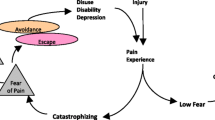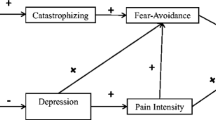Abstract
Purpose
In the fear-avoidance model (FAM) of chronic pain, pain-related fear is one of the most prominent predictors of negative adjustment outcomes. While existing data point to the effects of anxiety sensitivity, pain hypervigilance, and pain catastrophizing on pain-related fear, the nature of their multivariate relationships remains unclear. This study explored the possible mediating role of pain hypervigilance in the relationship of anxiety sensitivity and pain catastrophizing with pain-related fear, and their effects on quality of life (QoL) outcomes within the FAM framework.
Methods
A sample of 401 Chinese patients with chronic musculoskeletal pain completed the standardized measures assessing the FAM components and QoL. Structural equation modeling (SEM) was used to evaluate six hypothesized models.
Results
Results of SEM showed adequate data-model fit [comparative fit indexes (CFIs) ranging from 0.92 to 0.94] on models which specified pain hypervigilance as mediator of anxiety sensitivity and pain catastrophizing with pain-related fear on two QoL outcomes (QoL-Physical and QoL-Mental). Results consistent with net suppression effects of pain catastrophizing on anxiety sensitivity were found in SEM when both anxiety sensitivity and pain catastrophizing were included in the same full model to predict QoL-Physical (CFI = 0.95; Sobel z = 8.06, p < 0.001) and QoL-Mental (CFI = 0.93; Sobel z = 8.31, p < 0.001).
Conclusions
These cross-sectional analyses gave results consistent with pain hypervigilance, mediating the relationship of pain catastrophic cognition and anxiety sensitivity with pain-related fear. The net suppression effects of pain catastrophizing point to anxiety sensitivity, enhancing the effect of pain catastrophic cognition on pain hypervigilance. These findings elucidate how the interdependence of dispositional factors might influence pain adjustment and functioning.


Similar content being viewed by others
References
Vlaeyen, J. W., & Linton, S. J. (2000). Fear-avoidance and its consequences in chronic musculoskeletal pain: A state of the art. Pain, 85(3), 317–332.
Leeuw, M., Houben, R. M. A., Severeijns, R., Picavet, H. S. J., Schouten, E. G. W., & Vlaeyen, J. W. S. (2007). Pain-related fear in low back pain: A prospective study in the general population. European Journal of Pain, 11(3), 256–266.
Geisser, M. E., Haig, A. J., Wallbom, A. S., & Wiggert, E. A. (2004). Pain-related fear, lumbar flexion, and dynamic EMG among persons with chronic musculoskeletal low back pain. The Clinical journal of pain, 20(2), 61–69.
Asmundson, G. J., Wright, K. D., & Hadjistavropoulos, H. D. (2000). Anxiety sensitivity and disabling chronic health conditions: State of the art and future directions. Scandinavian Journal of Behavioral Therapy, 29, 100–117.
Asmundson, G. J., & Norton, G. R. (1995). Anxiety sensitivity in patients with physically unexplained chronic back pain: A preliminary report. Behavior Research and Therapy, 33, 771–777.
Asmundson, G. J., & Taylor, G. J. (1996). Role of anxiety sensitivity in pain-related fear and avoidance. Journal of Behavioral Medicine, 19(6), 577–586.
Waddell, G., Newton, M., Henderson, I., Somerville, D., & Main, C. J. (1993). A fear–avoidance beliefs questionnaire (FABQ) and the role of fear–avoidance beliefs in chronic low back pain and disability. Pain, 52, 157–168.
Asmundson, G. J. G., & Hadjistavropoulos, H. D. (2007). Is high fear of pain associated with attentional biases for pain-related or general threat? A categorical reanalysis. The Journal of Pain: Official Journal of the American Pain Society, 8(1), 11–18.
Greenberg, J., & Burns, J. W. (2003). Pain anxiety among chronic pain patients: Specific phobia or manifestation of anxiety sensitivity? Behaviour Research and Therapy, 41(2), 223–240.
Reiss, S., & McNally, R. J. (1985). Expectancy model of fear. In S. Reiss & R. R. Bootzin (Eds.), Theoretical issues in behavior therapy. San Diego: Academic Press.
Asmundson, G. J., Kuperos, J. L., & Norton, G. R. (1997). Do patients with chronic pain selectively attend to pain-related information: Preliminary evidence for the mediating role of fear. Pain, 72, 27–32.
McCracken, L. (1997). Attention to pain in persons with chronic pain: A behavioral approach. Behavior Therapy, 28, 271–284.
Crombez, G., Vervaet, L., Lysens, R., Baeyens, F., & Eelen, P. (1998). Avoidance and confrontation of painful, back straining movements in chronic back pain patients. Behavioral Modification, 22, 62–77.
Van Damme, S., Crombez, G., & Eccleston, C. (2004). The anticipation of pain modulates spatial attention: Evidence for pain-specificity in high-pain catastrophizers. Pain, 111, 392–399.
Vancleef, L. M. G., & Peters, M. L. (2006). Pain catastrophizing, but not injury/illness sensitivity or anxiety sensitivity, enhances attentional interference by pain. Journal of Pain, 7, 23–30.
Van Damme, S., Crombez, G., & Eccleston, C. (2002). Retarded disengagement from pain cues: The effects of pain catastrophizing and pain expectancy. Pain, 100, 111–118.
Von Korff, M., Dworkin, S. F., & Le Resche, L. (1990). Graded chronic pain status: An epidemiologic evaluation. Pain, 40(3), 279–291.
Fielding, R., & Wong, W. S. (2008). The prevalence of chronic pain, fatigue, and insomnia in the general population of Hong Kong. Final report to the Health, Welfare and Food Bureau, Government of the Hong Kong Special Administrative Region, China Hong Kong: School of Public Health, the University of Hong Kong.
Ware, J. J., Kosinski, M., & Keller, S. D. (1996). A 12-Item Short-Form Health Survey: Construction of scales and preliminary tests of reliability and validity. Medical Care, 34(3), 220–233.
Lam, C. L., Tse, E. Y., & Gandek, B. (2005). Is the standard SF-12 health survey valid and equivalent for a Chinese population? Quality of Life Research, 14(2), 539–547.
Peterson, R. A., & Reiss, S. (1992). Anxiety sensitivity index manual (2nd ed.). Worthington, OH: International Diagnostic Systems.
Li, Q.-Q., Guo, L.-T., & Feng, Z.-Z. (2006). Reliability and validity of Chinese revision of the anxiety sensitivity index-revised. Chinese Mental Health Journal, 20(10), 675–678.
Reiss, S., Peterson, R. A., Gursky, D. M., & McNally, R. J. (1995). Anxiety sensitivity, anxiety frequency, and the prediction of fearfulness. Behavior Research and Therapy, 24, 1–8.
Wong, W. S., McCracken, L., & Fielding, R. (2011). Confirmatory factor analysis of the Chinese version of the Pain Vigilance and Awareness Questionnaire (ChPVAQ) among Chinese patients with chronic pain. Pain Medicine, 12, 1018–1025.
Roelofs, J., Peters, M. L., McCracken, L., & Vlaeyen, J. W. S. (2003). The pain vigilance and awareness questionnaire (PVAQ): Further psychometric evaluation in fibromyalgia and other chronic pain syndromes. Pain, 101(3), 299–306.
Sullivan, M. J., Bishop, S. R., & Pivik, J. (1995). The Pain Catastrophizing Scale: Development and validation. Psychological Assessment, 7(4), 524–532.
Yap, J. C., Lau, J., Chen, P. P., Gin, T., Wong, T., Chan, I., et al. (2008). Validation of the Chinese Pain Catastrophizing Scale (HK-PCS) in patients with chronic pain. Pain Medicine, 9(2), 186–195.
Kori, S. H., Miller, R. P., & Todd, D. D. (1990). Kinesiophobia: A new view of chronic pain behavior. Pain Management, Jan/Feb, 35–43.
Wong, W. S., Kwok, H. Y., Luk, K. D. K., Chow, Y. F., Mak, K. H., Tam, B. K. H., et al. (2010). Fear of movement/(re)injury in Chinese chronic pain patients: Factorial validity of the Chinese version of the Tampa Scale for Kinesiophobia. Journal of Rehabilitation Medicine, 42, 620–629.
Browne, M. W., & Cudeck, R. (1993). Alternative ways of assessing model fit. In K. A. Bollen & J. S. Long (Eds.), Testing structural equation models Newbury Park. CA: Sage.
Hu, L. T., & Bentler, P. M. (1999). Cutoff criteria for fit indexes in covariance structure analysis: Conventional criteria versus new alternatives. Structural Equation Modeling, 6(1), 1–55.
Muthen, L. K., & Muthen, B. O. (1998). Mplus User’s Guide (6th Ed). Los Angeles, CA: Muthén & Muthén.
Paulhus, D. L., Robins, R. W., Trzesniewski, K. H., & Tracy, J. L. (2004). Two replicable suppressor situations in personality research. Multivariate Behavioral Research, 39, 303–328.
Burton, A. K., Tillotson, K. M., Main, C. J., & Hollis, S. (1995). Psychosocial predictors of outcome in acute and subchronic low back trouble. Spine, 20, 722–728.
Affleck, G., Tennen, H., Urrows, S., & Higgins, P. (1992). Neuroticism and the pain-mood relation in rheumatoid arthritis: Insights from a prospective daily study. Journal of Consulting and Clinical Psychology, 60(1), 119–126.
Hirsh, A. T., George, S., Riley, J., & Robinson, M. (2005). Sex differences and construct redundancy of the Coping Strategies Questionnaire—Catastrophizing Subscale. Journal of Pain, 6(3, Suppl. 1), S60.
Hirsh, A. T., George, S. Z., Riley, J. L, I. I. I., & Robinson, M. E. (2007). An evaluation of the measurement of pain catastrophizing by the coping strategies questionnaire. European Journal of Pain, 11(1), 75–81.
Sullivan, M. J., & D’Eon, J. L. (1990). Relation between catastrophizing and depression in chronic pain patients. Journal of Abnormal Psychology, 99(3), 260–263.
Quartana, P. J., Campbell, C. M., & Edwards, R. R. (2009). Pain catastrophizing: A critical review. Expert Review in Neurotherapy, 9, 745–758.
Wideman, T. H., Asmundson, G. J., Smeets, R. J. E. M., Zautra, A., Simmonds, M. J., Sullivan, J. L., et al. (2013). Rethinking the fear avoidance model: Toward a multidimensional framework of pain-related disability. Pain, 154, 2262–2265.
Pincus, T., Smeets, R. J. E. M., Simmonds, M. J., & Sullivan, J. L. (2010). The fear avoidance model disentangled: Improving the clinical utility of the fear avoidance model. Clinical Journal of Pain, 26, 739–746.
Acknowledgement
This project was supported by Hong Kong Research Grants Council’s General Research Fund (Project #: 150810) awarded to the first author (W.S. Wong). The authors would like to acknowledge support from the Pain Unit of three public hospitals in Hong Kong: the Alice Ho Mui Ling Nethersole Hospital, the Queen Elizabeth Hospital, and the United Christian Hospital. We also thank all patients for their participation in the project.
Author information
Authors and Affiliations
Corresponding author
Rights and permissions
About this article
Cite this article
Wong, W.S., Lam, H.M.J., Chow, Y.F. et al. The effects of anxiety sensitivity, pain hypervigilance, and pain catastrophizing on quality of life outcomes of patients with chronic pain: a preliminary, cross-sectional analysis. Qual Life Res 23, 2333–2341 (2014). https://doi.org/10.1007/s11136-014-0683-y
Accepted:
Published:
Issue Date:
DOI: https://doi.org/10.1007/s11136-014-0683-y




